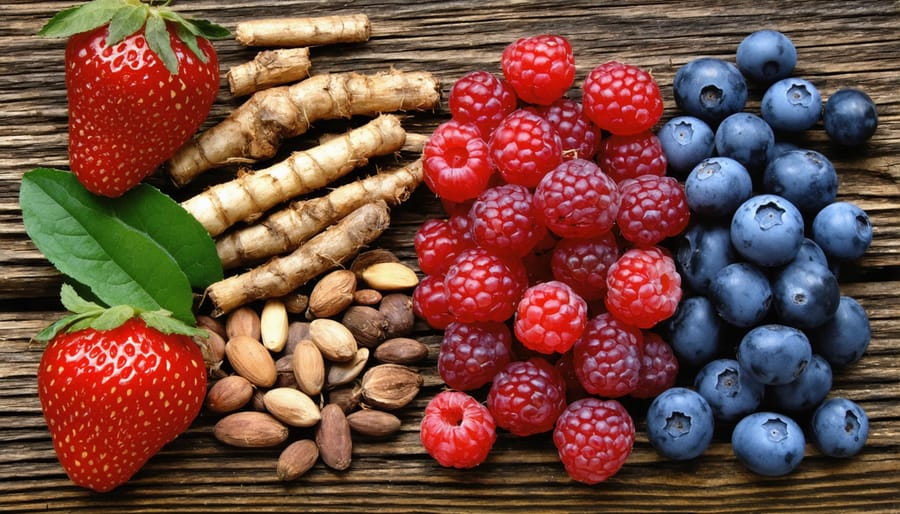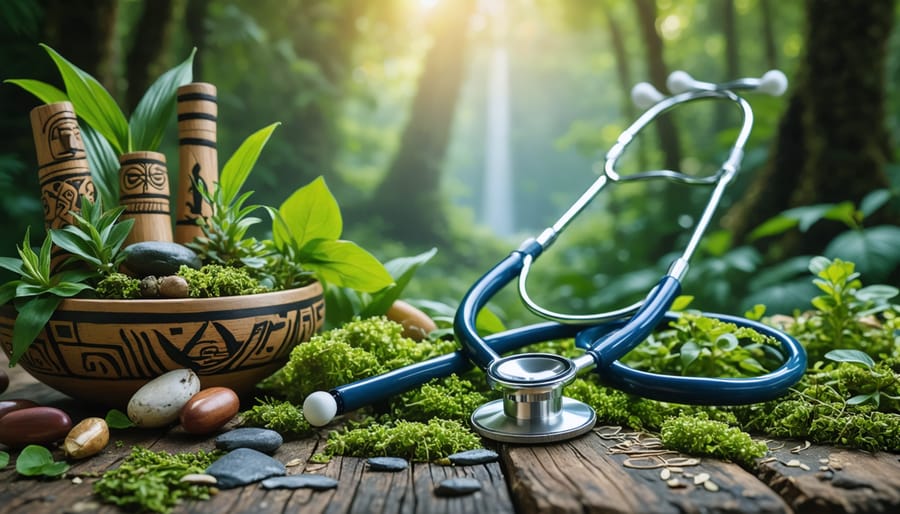Traditional Indigenous healing practices offer powerful solutions to modern health challenges, particularly in addressing indigenous health disparities and chronic diseases. For generations, Indigenous communities across Alberta have maintained vibrant knowledge systems that combine physical, mental, and spiritual well-being to prevent and manage illness. These time-tested approaches, from traditional plant medicines to holistic healing ceremonies, work alongside contemporary medical practices to provide comprehensive health solutions.
Recent research reveals that Indigenous healing methods can significantly reduce the risk of diabetes, heart disease, and other chronic conditions through their emphasis on whole-person wellness and connection to the land. By integrating these ancestral practices with modern healthcare, communities are experiencing improved health outcomes and stronger cultural connections. Understanding and respecting these traditional approaches isn’t just about preserving cultural heritage – it’s about accessing proven, effective solutions for today’s health challenges.
Understanding Traditional Indigenous Health Practices
The Holistic Healing Philosophy
Indigenous healing practices take a fundamentally different approach from Western medicine by viewing health as an interconnected web of physical, mental, emotional, and spiritual well-being. This holistic perspective recognizes that true healing can’t happen by treating symptoms in isolation – instead, it requires addressing the whole person and their connection to community and environment.
Traditional healers understand that illness often stems from imbalances in these various aspects of life, including social determinants of health. They use ceremonies, plant medicines, counseling, and lifestyle guidance to restore harmony across all dimensions of wellness.
This integrated approach means that treating a physical ailment might involve addressing emotional trauma, strengthening spiritual practices, or healing relationships within the community. The focus is on prevention and maintaining balance rather than just responding to illness after it develops.
Connection to Land and Nature
Indigenous peoples have long understood that their physical and mental well-being is deeply connected to the natural world around them. This relationship goes beyond simply using plants for medicine – it encompasses a holistic understanding of how environmental health directly impacts human health. Traditional knowledge teaches that spending time on the land, harvesting traditional foods, and maintaining clean water sources all play vital roles in preventing illness and maintaining wellness.
Many Indigenous communities practice seasonal activities that naturally support health, like berry picking in summer, hunting in fall, and gathering medicines throughout the year. These activities provide both physical exercise and nutritious traditional foods while strengthening community bonds. The act of walking on the land, breathing fresh air, and connecting with nature has been shown to reduce stress, lower blood pressure, and improve overall mental health.
Today, many Indigenous health programs incorporate land-based healing, recognizing that reconnecting with traditional territories and practices is fundamental to addressing modern health challenges.

Indigenous Solutions for Modern Health Challenges

Traditional Foods and Diabetes Prevention
Traditional indigenous diets have long played a crucial role in maintaining health and preventing diseases like diabetes. These time-tested eating patterns typically include foods with a low glycemic index, such as wild game, fish, berries, and root vegetables, which help regulate blood sugar levels naturally.
Many indigenous communities traditionally relied on foods like wild rice, saskatoon berries, and lean meats from buffalo or deer. These foods are not only nutritious but also help maintain steady blood sugar levels throughout the day. The high fiber content in traditional plant foods like chokecherries and Jerusalem artichokes also aids in slowing down sugar absorption.
The traditional practice of harvesting and preparing seasonal foods ensures a diverse, nutrient-rich diet that naturally supports metabolic health. For example, spring medicines like dandelion and burdock root help cleanse the body, while fall harvests of nuts and berries provide essential nutrients for winter.
Today, incorporating these traditional food principles into modern diets can help manage and prevent diabetes. Simple steps include choosing whole, unprocessed foods, eating according to seasonal availability, and incorporating traditional preparation methods like slow cooking and fermentation.
Local food programs in Alberta are working to revive these traditional food practices, offering workshops on indigenous food gathering, preparation, and preservation. These initiatives help community members reconnect with their cultural food heritage while promoting better health outcomes.
Natural Movement and Heart Health
Traditional Indigenous communities have long understood the connection between natural movement and heart health. Daily activities like hunting, gathering, and traditional dance weren’t just cultural practices – they were essential forms of exercise that kept the heart strong and the body healthy.
These movement patterns typically involve full-body engagement, varying intensities, and connection with nature. Walking on uneven terrain while foraging strengthens leg muscles and improves balance. Traditional hunting requires bursts of energy followed by periods of careful stalking, creating a natural interval training effect that benefits cardiovascular health.
Ceremonial dances remain particularly valuable for heart health, combining rhythmic movement with spiritual connection. Many traditional dances involve continuous movement for extended periods, helping build endurance and strengthen the heart muscle. The social aspect of group dances also contributes to emotional well-being, which research shows is closely linked to heart health.
Today, we can incorporate these principles into our modern lives. Try taking nature walks on varying terrain, practicing traditional dance movements, or engaging in burst-and-recovery activities like sprinting and walking. These natural movement patterns not only honor Indigenous wisdom but also provide effective cardiovascular exercise without the need for gym equipment.
Remember that movement shouldn’t feel like a chore – Indigenous practices teach us that physical activity can be both purposeful and enjoyable when integrated naturally into daily life.

Integrating Indigenous Wisdom with Modern Healthcare
Daily Wellness Practices
Traditional Indigenous wellness practices offer simple yet powerful ways to maintain daily health. Start your morning by practicing mindful breathing while facing east, acknowledging the new day. This helps reduce stress and centers your mind for the day ahead.
Incorporate natural movement throughout your day by taking regular walking breaks, preferably in natural settings like parks or wooded areas. The connection with nature strengthens both physical and mental well-being.
Consider adding traditional teas to your daily routine, such as cedar or sweetgrass tea, known for their immune-supporting properties. Remember to harvest or source these materials respectfully and sustainably from trusted suppliers.
Practice gratitude before meals by taking a moment to acknowledge where your food comes from. This not only promotes mindful eating but also helps maintain a healthy relationship with food.
End your day with a cleansing ritual, such as smudging with sage or taking a warm bath with natural herbs. These practices can help clear negative energy and promote restful sleep.
Remember that wellness is about balance – physical, mental, emotional, and spiritual. Listen to your body and adjust these practices to suit your personal needs and circumstances.
Working with Healthcare Providers
When discussing traditional Indigenous healing practices with your healthcare provider, open and honest communication is essential. Start by sharing your interest in incorporating traditional approaches alongside conventional medicine. Many healthcare providers in Alberta are becoming more familiar with culturally competent healthcare and may be open to creating an integrated treatment plan.
Keep a detailed record of any traditional medicines or practices you’re using, including herbs, ceremonies, or consultations with Indigenous healers. This information helps your healthcare provider understand your complete health journey and ensure all treatments work together safely.
If you encounter resistance or dismissal, consider seeking a second opinion or requesting a referral to a provider who has experience working with Indigenous patients. Many Alberta health centers now have Indigenous liaison workers who can help bridge cultural and communication gaps between patients and healthcare providers.
Remember, you have the right to receive care that respects your cultural beliefs while ensuring your safety and well-being. Don’t hesitate to ask questions and advocate for your health needs.
Local Indigenous Health Resources
Alberta offers numerous resources for accessing traditional Indigenous health services and knowledge. The Alberta Indigenous Virtual Care Clinic provides remote consultations with Indigenous healthcare providers, combining traditional healing practices with modern medical care. You can access their services by calling 1-888-342-4822 or visiting their website.
Several Indigenous health centers across the province offer in-person care and cultural healing programs. The Maskwacis Health Services, serving four First Nations communities, welcomes both Indigenous and non-Indigenous patients seeking traditional healing approaches. In Edmonton, the Bent Arrow Traditional Healing Society provides culturally-based health services and educational programs about Indigenous healing practices.
The Alberta First Nations Information Governance Centre maintains a database of traditional medicine practitioners and knowledge keepers. They can connect you with local healers who specialize in plant-based medicines and traditional healing ceremonies.
For those interested in learning more about Indigenous approaches to health, the Indigenous Wellness Program at the University of Alberta offers workshops and educational resources. These programs cover topics like traditional plant medicines, ceremonial practices, and holistic wellness approaches.
The Aboriginal Friendship Centre of Calgary provides cultural support and can help coordinate access to traditional healers and health services. They also offer regular wellness circles and educational sessions about Indigenous approaches to managing chronic conditions.
Remember to approach these services with respect for Indigenous protocols and traditions. Many healing centers require advance contact and may have specific guidelines for non-Indigenous participants seeking traditional health services.
Indigenous approaches to health and wellness offer valuable insights and proven practices that can enhance our modern healthcare journey. These traditional methods, developed over thousands of years, focus on whole-person wellness and natural healing that many Albertans are finding beneficial today. By understanding and respecting these time-tested practices, we can build a more comprehensive approach to preventing and managing chronic diseases.
Whether you’re interested in incorporating traditional herbs, exploring mindful practices, or learning from indigenous dietary wisdom, there are many ways to begin your journey. Consider reaching out to local indigenous health centers, attending community workshops, or consulting with traditional knowledge keepers to learn more about these practices firsthand.
Remember that indigenous healing is not just about treating symptoms—it’s about fostering balance between physical, mental, spiritual, and emotional well-being. By embracing these holistic approaches alongside modern medicine, we can work toward better health outcomes for our communities.
Take the first step today by exploring local resources and connecting with indigenous health practitioners in your area. Your journey to better health might just begin with wisdom that has sustained generations.

